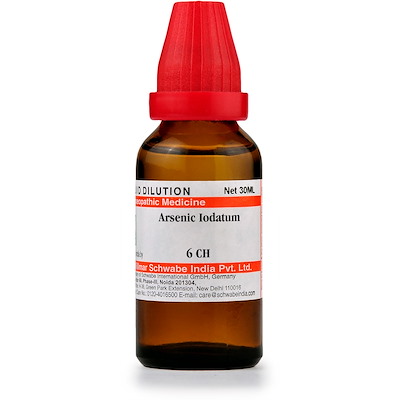Description
ARSENICUM IODATUM – ARSENICUM IODATUM
Source: Iodide of Arsenic
Is to be preferred for persistently irritating, corrosive discharges. The discharge irritates the membrane from which it flows and over which it flows. The discharge may be fetid, watery, and the mucous membrane is always red, angry, swollen; itches and burns. Influenza, hay-fever, old nasal catarrhs, and catarrh of middle ear. Swelling of tissues within the nose. Hypertrophied condition of eustachian tube and deafness. Senile heart, myocarditis and fatty degeneration. Pulse shotty. Chronic aortitis. Epithelioma of the lip. Cancer of breast after ulceration has set in. It seems probable that in Arsenic iod, we have a remedy most closely allied to manifestations of tuberculosis. In the early stages of tuberculosis, even though there is an afternoon rise in temperature, Ars jod is very effective. It will be indicated by a profound prostration, rapid, irritable pulse, recurring fever and sweats, emaciation; tendency to diarrhea. Chronic pneumonia, with abscess in lung. Hectic; debility; night sweats. This remedy is also to be remembered in phthisis with hoarse, racking cough and profuse expectoration of a purulent nature, and attended with cardiac weakness, emaciation and general debility; in chronic, watery diarrhea in phthisical subjects; in cases of emaciation with good appetite; in amenorrhea, with anaemic palpitation and dyspnea. In chronic pneumonia, when abscess is about to form. Great emaciation. Arteriosclerosis, myocardial degeneration and senile heart. Threatened pyaemia (Pyrog; Methyl blue).
Head
–Vertigo, with tremulous feeling, especially in aged.
Nose
–Thin, watery, irritating, excoriating discharge from anterior and posterior nares; sneezing. Hay-fever. Irritation and tingling of nose constant desire to sneeze (Pollanin). Chronic nasal catarrh; swollen nose; profuse, thick, yellow discharge; ulcers; membrane sore and excoriated. Aggravation by sneezing.
Throat
–Burning in pharynx. Tonsils swollen. Thick membrane from fauces to lips. Breath fetid, glandular involvement. Diphtheria. Chronic follicular pharyngitis. Eyes and Ears.–Scrofulous ophthalmia. Otitis, with fetid, corrosive discharge. Thickening of tympanum. Burning, acrid coryza.
Stomach
–Pain and pyrosis. Vomiting an hour after food. Nausea distressing. Pain in epigastrium. Intense thirst; water is immediately ejected.
Respiratory
–Slight hacking cough, with dry and stopped-up nostrils. Pleuritis exudativa. Chronic bronchitis. Pulmonary tuberculosis. Pneumonia that fails to clear up. Broncho-pneumonia after grippe. Cough dry, with little difficult expectoration. Aphonia.
Fever
–Recurrent fever and sweats. Drenching night-sweats. Pulse rapid, feeble, weak, irregular. Chilly, cannot endure cold.
Skin
–Dry, scaly, itching. Marked exfoliation of skin in large scales, leaving a raw exuding surface beneath. Ichthyosis. Enlarged scrofulous glands. Venereal bubo. Debilitating night-sweats. Eczema of the beard; watery, oozing, itching; worse, washing. Emaciation. Psoriasis. Acne hard, shotty, indurated base with pustule at apex.
Relationship
–Compare: Tuberculinum; Antimon iod. In hay-fever, compare: Aralia; Naphthalin; Rosa; Sang nit.
Dose
–Second and third trituration. Ought to be prepared fresh and protected from light. Continued for some time. Clinically, it has been found advisable in tuberculosis to begin with about the 4x and gradually go lower to the second x trit, 5 grains 3 times a day.
Disclaimer: The description given here is only for educational purpose, which has been extracted from multiple books related to homeopathy; and must not be considered as substitute to any medical consultation/prescription of qualified doctors. It must not be used for any medico-legal purpose. Medicines Mall or any of its associates, directors, employees will not be responsible for the authenticity of the contents or for any mistake.
Patient must take proper advice of qualified doctors before taking any dose of this medicine, as self medication may be harmful.




Reviews
There are no reviews yet.